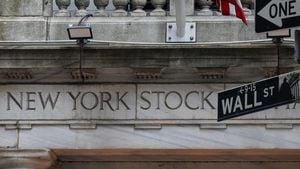Gold prices have surged to unprecedented heights, reaching over $3,200 an ounce as of April 11, 2025, amidst escalating global trade tensions and investor anxiety. The precious metal's rise is attributed to a confluence of factors, including President Donald Trump's tariff policies, a weakening U.S. dollar, and increased demand from central banks.
On Friday, gold prices in Singapore climbed by 1.2% to $3,215.73 an ounce, aiming for a weekly gain of nearly 6%. This follows a remarkable rally that has seen gold's value increase by more than 20% this year alone. The ongoing uncertainty surrounding U.S.-China trade negotiations has intensified selloffs in U.S. stocks, bonds, and the dollar, reinforcing gold's status as a safe haven asset.
Kevin Hassett, the White House Economic Council Director, attempted to reassure markets by stating that the United States is "well advanced" in its discussions with economic partners. However, the market's response suggests a deep skepticism regarding the resolution of these trade issues. As a result, many investors are flocking to gold, viewing it as a long-term hedge against economic instability.
In India, the price of gold has also reached record levels, with 24-karat gold priced at ₹93,390 per 10 grams and 22-karat gold at ₹85,610 per 10 grams. Even 18-karat gold, commonly used in jewelry, climbed to ₹70,050 per 10 grams. Manav Modi, Senior Analyst at Motilal Oswal Financial Services Ltd, noted, "This rally is not just about inflation. It's about fear. With trade tensions between the U.S. and China intensifying and global growth looking shaky, investors are looking at gold as a long-term hedge."
The recent surge in gold prices can be traced back to several key factors:
- Trade War Escalation: President Trump has increased tariffs on all Chinese imports to 145%, provoking a tit-for-tat response from Beijing. This has heightened fears of a prolonged trade conflict.
- Weaker Dollar: The U.S. Dollar Index has fallen below 100, making gold more affordable for buyers using other currencies. This decline has prompted a shift away from USD-based assets.
- Central Bank Buying: Global central banks are reportedly reducing their U.S. bond holdings while increasing their gold reserves, further driving demand.
- Recession Fears: Recent U.S. inflation data revealed a broad cooling in March, leading traders to anticipate multiple interest-rate cuts by the end of the year. Lower interest rates typically favor gold, which does not yield interest.
Dominic Schnider of UBS Global Wealth Management expressed optimism about gold's trajectory, stating on Bloomberg Television, "The next step is going to be, at some point, the Fed coming in — and that gives the next leg up for gold." This sentiment is echoed by analysts who believe that gold could rise further, with Augmont Bullion suggesting the next resistance level internationally is $3,300 per ounce, approximately ₹95,000 per 10 grams in India.
The market dynamics surrounding gold are further complicated by the recent volatility in the U.S. stock market. Following Trump's inconsistent tariff communications, the S&P 500 fell by 5.8%, while the Dow Jones Industrial Average dropped by 1,746 points. This sharp decline underscores the market's reaction to the uncertainty created by the tariff situation.
As investors continue to grapple with the implications of these trade policies, the appeal of gold as a protective asset remains strong. The ongoing volatility in global markets, driven by tariff-related concerns, suggests that the outlook for gold will remain positive, bolstered by expectations of further fiscal interventions and easing measures.
In summary, gold's rise to record levels reflects a complex interplay of economic factors, including trade tensions, currency fluctuations, and central bank strategies. As the situation evolves, investors are likely to keep a close eye on gold as a barometer of economic stability and a safe haven in uncertain times.






